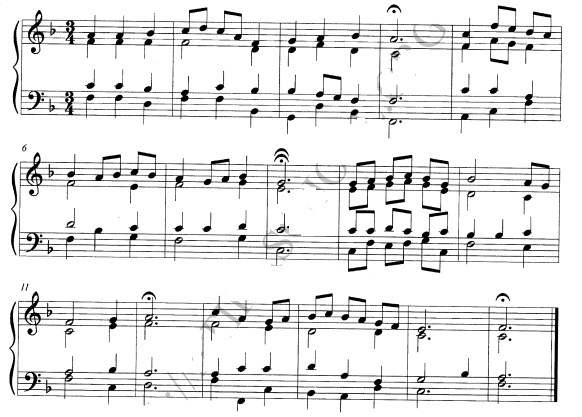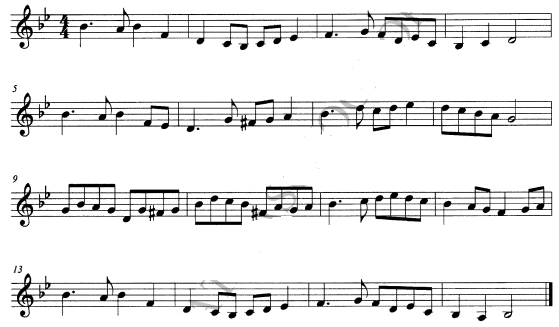TEST ONE: RHYTHM ON MONOTONE
Test 1
- Drum Rhythm
You are to write on monotone, the rhythm of the following repetitive drum pattern. You are required to add time signature and bar lines and also group the notes. The rhythmic pattern will be played four times.
Here is the quaver pulse followed by the first play through.
(Silence: 2 seconds) .)
(Silence: 30 seconds)
Here is the second play through (Play rhythmic pattern)
(Silence: 30 seconds)
Here is the third play through (Play rhythmic pattern)
(Silence: 30 seconds)
And now, the fourth and last play through (Play rhythmic pattern)
(Silence: 60 seconds) - Test 1:
Rhythm of a melody in simple time.
You are to write on monotone the rhythm of this melody, adding time signature and bar lines. The melody begins on the first beat of the bar. It will be played four times. Here is the crotchet pulse, followed by the first play through.
(Silence: 2 seconds)
(Silence: 3 seconds)
Here is the second play through (Play melody)
(Silence: 30 seconds)
Here is the third play through (Play melody)
(Silence: 30 seconds)
And now, the fourth and last play through (Play melody)
(Silence: 60 seconds)
(Play melody)
(Play melody) - Rhythm of a melody in compound time.
You are to write on monotone the rhythm of this melody, adding time signature and bar lines. The melody begins on the first beat of the bar. It will be played four times.
Here is the dotted crotchet pulse, followed by the first play through.
(Silence: 3 seconds)
Here is the second play through (Play melody)
(Silence: 30 seconds)
Here is the third play through (Play melody)
(Silence: 30 seconds)
And now, the fourth and last play through (Play melody)
(Silence: 60 seconds)
TEST TWO: MELODY
- Test 2 :Melody in a Major Key
You are to write the following melody in the key of B flat major. The melody will be played through once, then the first phrase will be played twice and the second phrase twice. Finally the whole melody will be played right through once again. Write the treble clef and the key signature of B flat major now.
(Silence: 10 seconds)
The melody is intime. Write the time signature now.
(Silence: 10 seconds)
The melody begins on the first beat of the bar. Here is the crotchet pulse.
Here is the tonic chord of B flat major and the key note, followed by the whole melody.
(Silence: 2 seconds)
(Silence: 40 seconds)
And now, here is the tonic chord and key-note again, followed by the first phrase.
(Play 1st phrase-bar 1 and 2)
(Silence: 40 seconds)
Here is the first phrase again. (Play Ist phrase-bar 1 and 2)
(Silence: 40 seconds)
Now, here is the keynote and the second phrase.
(Play keynote and 2nd phrase-bar 3 and 4)
(Silence: 40 seconds)
Here is the second phrase again.
(Play 2nd phrase-bar 3 and 4)
(Silence: 40 seconds)
Finally, here is the tonic chord followed by the whole melody.
(Silence: 60 seconds) - Melody in a Minor key
You are to write the following melody in the key of B minor. The melody will be played through once, then the first phrase will be played twice and the second phrase twice. Finally the whole melody will be played right through once again. Write the treble clef and the key signature of B minor now.
(Silence: 10 seconds)
The melody is intime. Write the time signature now.
(Silence: 10 seconds)
The melody begins on the first beat of the bar. Here is the crotchet pulse.
(Silence: 2 seconds)
Here is the tonic chord of B minor and the key note, followed by the whole melody
(Silence: 2 seconds)
(Silence: 40 seconds)
And now, here is the tonic chord and key-note again, followed by the first phrase.
(Play Ist phrase-bar 1 and 2)
(Silence: 40 seconds)
Here is the first phrase again.
(Play Ist phrase-bar 1 and 2)
(Silence: 40 seconds)
Now, here is the keynote and the second phrase.
(Play keynote and 2nd phrase-bar 3 and 4)
(Silence: 40 seconds)
Here is the second phrase again.
(Play 2nd phrase-bar 3 and 4)
(Silence: 40 seconds)
Finally, here is the tonic chord followed by the whole melody.
(Silence: 60 seconds)
TEST 3: INTERVALS
Two intervals will be sounded harmonically. Each interval will be sounded twice. You are to describe each of the intervals.
(Silence: 2 seconds)
- Here is the first interval.
(Silence: 20 seconds)
Here is the first interval again (Play the interval)
(Silence: 20 seconds) - Here is the second interval.
(Silence: 20 seconds)
Here is the second interval again. (Play the interval)
(Silence: 20 seconds)
TEST 4: CADENCES
There are four cadences in this passage, which will be played with a pause at each cadential point. You are required to name the cadences in the order in which they occur in the passage.
Here is the tonic chord followed by the first play through. (Play fonic chord of G major then passage below)
(Silence: 15 seconds)
Here is the second play through (play passage)
(Silence: 15 seconds)
Here is the third play through (play passage)
(Silence: 15 seconds)
And finally, the fourth and last play through (play passage)
(Silence: 20 seconds)
TEST FIVE: MODULATION
- Test 5 (a):
The following melody is in the key of B flat Major. It modulates once away from the tonic key. You are required to name the key to which the melody modulates before returning to the tonic. The melody will be played three times.
Here is the tonic chord of B flat Major, followed by the first play through.
(Play tonic chord of B flat major)
(Silence: 2 seconds)
(Silence: 15 seconds)
Here is the second play through (Play melody)
(Silence: 15 seconds)
And now, the third and final play through (Play melody)
(Silence: 30 seconds) - Test 5 (b):
The following melody is in the key of B major. The melody modulates once away from the tonic key. You are required to name the key to which the melody modulates before returning to the tonic. The melody will be played three times. Here is the tonic chord of B major followed by the first play through
(Play tonic chord of B major)
(Silence: 2 seconds)
(Silence: 15 seconds)
Here is the second play through (Play melody)
(Silence: 15 seconds)
And now, the third and final play through (Play melody)
(Silence: 30 seconds)

MARKING SCHEME
- Rhythm
- Drum rhythm
½ mark for each correct beat X6 3 marks
½ mark for time signature ½ mark
½ mark for bar lines (as whole) ½ mark
Total (4 marks) - Rhythm of a melody in simple time
½ mark for each correct beat (bar 1-3) x12 (6 marks)
1 mark for semibreve in bar 4 (1 mark)
½ mark for correct time signature (½ mark)
½ mark for bar lines (as whole) (½ mark)
Total (8 marks) - Rhythm of a melody in compound time.
1 mark for each correct beat (bar 1-3) x 6 (6 marks)
1 mark for dotted minim in bar 4 (1 mark)
½ mark for correct time signature (½mark)
½ mark for bar lines (as whole) (½ mark)
Total (8 marks)
- Drum rhythm
-
- Melody in a major key.
½ mark for each correct note-pitch and value (17 notes) (8½ marks)
1 mark for correct key signature (1 mark)
½ mark for correct time signature (½ mark)- Deduct 1 mark per bar for incorrect note values Total (10 marks)
- Melody in a minor key.
½ mark for each correct note (pitch and value) (19 notes) (9½ marks)
½ mark for correct key signature (½ mark)
* Deduct 1 mark per bar for incorrect note values Total (10 marks)
- Melody in a major key.
- Intervals
-
Major 3rd
Award 1 mark for a fully described interval (½ mark)
Award only ½ mark if the interval is not fully named. e.g. 3rd -
Perfect 8ve (octave)
Award 1 mark for a fully described interval (1 ½ mark)
Award only ½ mark if the interval is not fully described. e.g. Octave/ 8th
-
- Cadences
- Plagal cadence (1 mark)
- Imperfect cadence (1 mark)
- Interrupted cadence (1 mark)
- Perfect cadence (1 mark)
Total 4 marks
- Modulation
-
The melody modulates from the tonic, (B flat major), to the relative minor key (G minor).
( Mark as a whole) (1½ mark) -
The melody modualets from the tonic ( B major), to the subdorminant (E Major).
Marks as a whole) (1½ mark)
-
Download KCSE 2017 Music Paper 2 with Marking scheme.
Tap Here to Download for 50/-
Get on WhatsApp for 50/-
Why download?
- ✔ To read offline at any time.
- ✔ To Print at your convenience
- ✔ Share Easily with Friends / Students



















